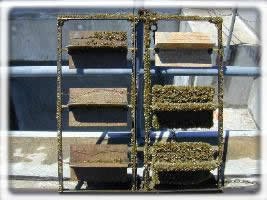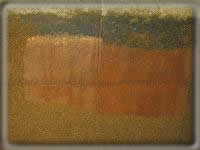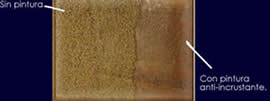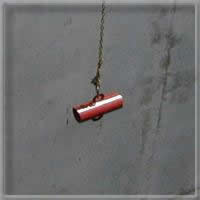
Monitor used to make studies of
reproductive biology ,population and individual growth of golden
mussel.


Close-up of the test
of anti-incrusting paints on concrete.

The boga has included the golden
mussel in its diet.
* The great adaptative and reproductive capacity of the golden mussel.
* The environmental characteristics of each geographical region.
* And
the individual features of each human environment (water system) to
be treated.
At the Facultad de Ciencias Naturales y Museo (UNLP) the
work of the research group on invading bivalves is aimed at generating
the biological knowledge and bio-essays needed for the control and prevention
of the golden mussel.
Learn about the biology of invasive species, both in the human and natural environment, is one of the most important requirements for an effective control and to avoid undesirable impacts of the environment. Every water intake in particular presents special structural characteristics to choose the type of control system that should be used (chemical and/or physical or biological). There is no general formula to be applied to control the golden mussel, but it is a combination of treatments according to the biological characteristics of the species in each environment and the characteristics of each human environment to be treated, in this case, water intakes (2).
COUNSELLING.
![]()
The Division of Zoology of the Museo de La Plata (FCNyM-UNLP), Argentina, through the research group on invading mollusks (GIMI), is responsible for generating the knowledge and apply it towards the prevention and control of the golden mussel (Limnoperna fortunei), as well as other invading mollusks.
Through the services program and under the direction of its technical representative, Dr. Gustavo Darrigran (CV), develops a framework to deal with this relatively new economic and environmental problem, such as the "macrofouling" in freshwater in South America, caused by the golden mussel.
The GIMI activities include:
• Coordinate and perform the generation of scientific knowledge on this species, or other invading mollusks, particularly oriented towards their control.
• Develop environmental and economically sustainable methods for prevention and control.
• Provide the necessary information on how to limit the expansion of the invading mollusks to new regions.
Bioessays.
![]()
![]() MAROÑAS, M. & C. DAMBORENEA. (2006). Efecto de biocidas y tolerancia a la exposición al aire. pp 167-180.
MAROÑAS, M. & C. DAMBORENEA. (2006). Efecto de biocidas y tolerancia a la exposición al aire. pp 167-180.
En: Darrigran & Damborenea (Eds.) Bio-invasion del mejillón dorado en el continente americano. Edulp, La Plata, 2006. 220 pág.
![]() PRIMERAS
ESTIMACIONES DE CONCETRACIONES LETALES DE UN BIOCIDA PARA EL MOLUSCO
INVASOR Limnoperna fortunei (MYTILIDAE)
PRIMERAS
ESTIMACIONES DE CONCETRACIONES LETALES DE UN BIOCIDA PARA EL MOLUSCO
INVASOR Limnoperna fortunei (MYTILIDAE)
G. Darrigran, M. Maroñas y D. Colautti.
ACTAS Seminario Internacional sobre Gestión Ambiental e Hidroelectricidad
19 al 22 de setiembre de 2001 - Complejo Hidroeléctrico de Salto Grande.
Pag. 131.
![]() CONCENTRACIONES
LETALES DE UN BIOCIDA PARA ADULTOS DEL MOLUSCO INVASOR Limnoperna
fortunei (Mytilidae)
CONCENTRACIONES
LETALES DE UN BIOCIDA PARA ADULTOS DEL MOLUSCO INVASOR Limnoperna
fortunei (Mytilidae)
G. Darrigran y C. Damborenea. ACTAS Seminario
Internacional sobre Gestión Ambiental e Hidroelectricidad 19 al 22 de
setiembre de 2001 - Complejo Hidroeléctrico de Salto Grande. Pag 119.
![]() TOLERANCIA
DEL "MEJILLÓN DORADO" Limnoperna Fortunei (DUNKER, 1857) (BIVALVIA:
MYTILIDAE) A LA EXPOSICIÓN AL AIRE.
TOLERANCIA
DEL "MEJILLÓN DORADO" Limnoperna Fortunei (DUNKER, 1857) (BIVALVIA:
MYTILIDAE) A LA EXPOSICIÓN AL AIRE.
Gustavo A. Darrigran, Miriam E. Maroñas
y Darío C. Colautti. ACTAS Seminario Internacional sobre Gestión Ambiental
e Hidroelectricidad 19 al 22 de setiembre de 2001 - Complejo Hidroeléctrico
de Salto Grande. Pag 123.
(1) CAPRARI, J. J. (2006). Pinturas anti incrustantes. pp 181-212. En: Darrigran & Damborenea (Eds.)
Bio-invasion del mejillón dorado en el continente americano. Edulp, La Plata, 2006. 220 pág.
(2) Darrigran y Damborenea (eds.) 2006. Aspectos generales vinculados a la prevención y control. Pp 154- 167.
En: Darrigran & Damborenea (Eds.) Bio-invasion del mejillón dorado en el continente americano. Edulp, La Plata, 2006. 220 pág.
DARRIGRAN, G. & P. PEREYRA (im press). Estandarización de métodos de control para Limnoperna fortunei.
En: S. Barbosa dos Santos; A. Dias Pimenta; M. Ammon Fernandez; S. Carvalho Thiengo (Organización).Tópicos em Malacologia – Ecos do XIX Encontro Brasileiro de Malacologia, Rio de Janeiro, Brasil (2008) IN PRESS (call pdf to invasion@cnym.unlp.edu.ar)
For
more information contact
us by e-mail:
invasion@fcnym.unlp.edu.ar
gdarrigran@hotmail.com
gdarrigran@malacología.com.ar
